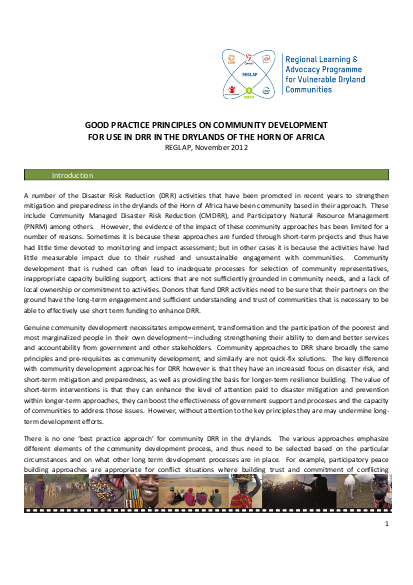
A number of the Disaster Risk Reduction (DRR) activities that have been promoted in recent years to strengthen mitigation and preparedness in the drylands of the Horn of Africa have been community based in their approach. These include Community Managed Disaster Risk Reduction (CMDRR), and Participatory Natural Resource Management (PNRM) among others. However, the evidence of the impact of these community approaches has been limited for a number of reasons. Sometimes it is because these approaches are funded through short-term projects and thus have had little time devoted to monitoring and impact assessment; but in other cases it is because the activities have had little measurable impact due to their rushed and unsustainable engagement with communities. Community development that is rushed can often lead to inadequate processes for selection of community representatives, inappropriate capacity building support, actions that are not sufficiently grounded in community needs, and a lack of local ownership or commitment to activities. Donors that fund DRR activities need to be sure that their partners on the ground have the long-term engagement and sufficient understanding and trust of communities that is necessary to be able to effectively use short term funding to enhance DRR. Genuine community development necessitates empowerment, transformation and the participation of the poorest and most marginalized people in their own development—including strengthening their ability to demand better services and accountability from government and other stakeholders. Community approaches to DRR share broadly the same principles and pre-requisites as community development, and similarly are not quick-fix solutions. The key difference with community development approaches for DRR however is that they have an increased focus on disaster risk, and short-term mitigation and preparedness, as well as providing the basis for longer-term resilience building. The value of short-term interventions is that they can enhance the level of attention paid to disaster mitigation and prevention within longer-term approaches, they can boost the effectiveness of government support and processes and the capacity of communities to address those issues. However, without attention to the key principles they are may undermine longterm development efforts. There is no one ‘best practice approach’ for community DRR in the drylands. The various approaches emphasize different elements of the community development process, and thus need to be selected based on the particular circumstances and on what other long term development processes are in place. For example, participatory peace building approaches are appropriate for conflict situations where building trust and commitment of conflicting communities is a priority. Participatory Natural Resource Management approaches are appropriate where use of natural resources is a major issue within DRR, and especially where there traditional resource management processes exist that can be strengthened. CMDRR may be appropriate where there is a need for increased emphasis and analysis of hazards and disaster prevention, and opportunities to feed community disaster risk sensitive development and contingency planning into government planning processes—both short and long term. A combination of different elements/methods may enhance effectiveness, but careful consideration needs to be given to monitoring the impact both positive and potentially negative as well as evaluating the approach for learning and replication. The key to a successful community approaches to DRR will depend on how the approaches are implemented and to what extent the implementation adheres to the fundamental principles of good practice in community development. Some of these key community development principles are outlined below, for further discussion and enrichment by DRR practitioners1.
